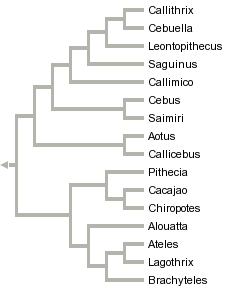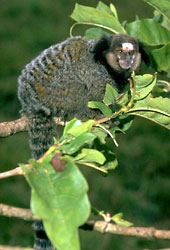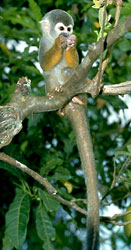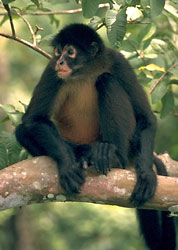Platyrrhini
New World Monkeys



This tree diagram shows the relationships between several groups of organisms.
The root of the current tree connects the organisms featured in this tree to their containing group and the rest of the Tree of Life. The basal branching point in the tree represents the ancestor of the other groups in the tree. This ancestor diversified over time into several descendent subgroups, which are represented as internal nodes and terminal taxa to the right.

You can click on the root to travel down the Tree of Life all the way to the root of all Life, and you can click on the names of descendent subgroups to travel up the Tree of Life all the way to individual species.
For more information on ToL tree formatting, please see Interpreting the Tree or Classification. To learn more about phylogenetic trees, please visit our Phylogenetic Biology pages.
close boxReferences
Bauer, K. and A. Schreiber. 1997. Double invasion of Tertiary island South America by ancestral New World monkeys? Biological-Journal of the Linnean Society 60:1-20.
Canavez, F. C., M. A. M. Moreira, J. J. Ladasky, A. Pissinatti, P. Parham, and H. N. Seuanez. 1999 Molecular phylogeny of New World primates (Platyrrhini) based on beta(2)-microglobulin DNA sequences. Molecular Phylogenetics And Evolution 12:74-82.
Canavez, F. C., M. A. M. Moreira, F. Simon, P. Parham, and H. N. Seuanez. 1999. Phylogenetic relationships of the callitrichinae (Platyrrhini, primates) based on beta(2)-microglobulin DNA sequences. American Journal of Primatology 48:225-236.
Harada, M. L., H. Schneider, and Schneider, M. P. C. 1995. DNA evidence on the phylogenetic systematics of new world monkeys: Support for the sister-grouping of Cebus and Saimiri from two unlinked nuclear genes. Molecular Phylogenetics and Evolution 4:331-349.
Horovitz, I. And R. D. E. MacPhee. 1999. The Quaternary Cuban platyrrhine Paralouatta varonai and the origin of Antillean monkeys. Journal of Human Evolution 36:33-68.
Horovitz, I. and A. Meyer. 1995. Systematics of New World monkeys (Platyrrhini, Primates) based on 16S mitochondrial DNA sequences: A comparative analysis of different weighting methods in cladistic analysis. Molecular Phylogenetics and Evolution 4:448-456.
Horovitz, I. and A. Meyer. 1997. Evolutionary trends in the ecology of New World monkeys inferred from a combined phylogenetic analysis of nuclear, mitochondrial, and morphological data. Pages 189-224 in Molecular Evolution and Adaptive Radiation (T. J. Givnish and K. J. Sytsma, eds.) Cambridge University Press, Cambridge, New York.
Horovitz, I., R. Zardoya, and A. Meyer. 1998. Platyrrhine systematics: A simultaneous analysis of molecular and morphological data. American Journal of Physical Anthropology 106:261-281.
Hugot, J. P. 1998. Phylogeny of neotropical monkeys: The interplay of morphological, molecular, and parasitological data. Molecular Phylogenetics and Evolution 9:408-413.
Kinzey, W. G. (ed.) 1997. New World Primates: Ecology, Evolution, and Behavior. Papers from the 87th Meeting of the American Anthropological Association. Aldine de Gruyter, New York.
Moreira, M. A. M. and H. N. Seuanez. 1999. Mitochondrial pseudogenes and phyletic relationships of Cebuella and Callithrix (Platyrrhini, Primates). Primates 40:353-364.
Meireles, C. M., J. Czelusniak, M. P. C. Schneider, J. A. P. C. Muniz, M. C. Brigido, H. S. Ferreira, and M. Goodman. 1999. Molecular phylogeny of Ateline new world monkeys (Platyrrhini, Atelinae) based on gamma-globin gene sequences: Evidence that Brachyteles is the sister group of Lagothrix. Molecular Phylogenetics and Evolution 12:10-30.
Porter, C. A., J. Czelusniak, H. Schneider, M. P. C. Schneider, I. Sampaio, and M. Goodman. 1997. Sequences of the primate epsilon-globin gene: implications for systematics of the marmosets and other New World primates. Gene 205:59-71.
Porter, C. A., J. Czelusniak, H. Schneider, M. P. C. Schneider, I. Sampaio, and M. Goodman. 1999. Sequences from the 5 ' flanking region of the epsilon-globin gene support the relationship of Callicebus with the Pitheciins. American Journal of Primatology 48:69-75.
Purvis, A. 1995. A composite estimate of primate phylogeny. Philosophical Transactions of the Royal Society of London (Series B) 348:405-421.
Ray, D. A., J. Xing, D. J. Hedges, M. A. Hall, M. E. Laborde, B. A. Anders, B. R. White, N. Stoilova, J. D. Fowlkes, K. E. Landry, L. G. Chemnick, O. A. Ryder and M. A. Batzer. 2005. Alu insertion loci and platyrrhine primate phylogeny. Molecular Phylogenetics and Evolution 35(1):117-126.
Schneider, H., M. P. C. Schneider, I. Sampaio, M. L. Harada, M. Stanhope, J. Czelusniak, and M. Goodman. 1993. Molecular phylogeny of the new world monkeys (Platyrrhini, Primates). Molecular Phylogenetics and Evolution 2:225-242.
Schneider, H., I. Sampaio, M. L. Harada, C. M. L. Barroso, M. P. C. Schneider, J. Czelusniak, and M. Goodman. 1996. Molecular phylogeny of the New World monkeys (Platyrrhini, Primates) based on two unlinked nuclear genes: IRBP intron 1 and epsilon-globin sequences. American Journal of Physical Anthropology 100:153-179.
Singer, S. S., J. Schmitz, C. Schwiegk, and H. Zischler. 2003. Molecular cladistic markers in New World monkey phylogeny (Platyrrhini, Primates). Molecular Phylogenetics and Evolution 26(3):490-501.
Van der Kuyl, A. C., C. L. Kuiken, J. T. Dekker, and J. Goudsmit. 1995. Phylogeny of African monkeys based upon mitochondrial 12S rRNA sequences. Journal of Molecular Evolution 40:173-180.
Wiesemueller, B, and H. Rothe. 1999. New World monkeys - A phylogenetic study. Zeitschrift für Morphologie und Anthropologie 82:115-157.
Information on the Internet
- Proyecto Tití (Project Tamarin). Cotton-top Tamarin Conservation in Colombia.
- Golden Lion Tamarin Conservation Program.
- Squirrel Monkey Breeding and Research Resource. University of South Alabama.
- International Primate Sanctuary Panama. Primate Behavior and Ecology Program of Florida State University-Panama Canal College Branch.
- Gremlins: Faces in the Forest. Information on marmosets and tamarins. PBS Online: NATURE on the Web.
- Callitrichidae (Marmosets, Tamarins). The University of Michigan Museum of Zoology Animal Diversity Web.
- Cebidae (Cebids, including Capuchin Monkeys, Howlers, Wooly Monkeys, Squirrel Monkeys, Night Monkeys, Titis, Uakaris, and others). The University of Michigan Museum of Zoology Animal Diversity Web.
Title Illustrations
- Marmoset. Callithrix jacchus, Brazil.
Photograph by Lloyd Glenn Ingles, courtesy CalPhotos, copyright © 2001 - Common squirrel monkey, Saimiri sciureus. Brazil.
Photograph by Lloyd Glenn Ingles, courtesy CalPhotos, copyright © 2001 - Red spider monkey, Ateles sp., Panama.
Photograph by Lloyd Glenn Ingles, courtesy CalPhotos, copyright © 2001











